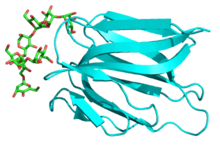Griffithsin
| Griffithsin | |||||||
|---|---|---|---|---|---|---|---|
 | |||||||
| Identifiers | |||||||
| Organism | |||||||
| Symbol | GRTF | ||||||
| PDB | 3ll2 More structures | ||||||
| UniProt | P84801 | ||||||
| |||||||
Griffithsin is a protein isolated from the red algae Griffithsia. It has a 121-amino acid sequence[2] which exhibits a Jacalin-like lectin fold. Several structures of this protein have been solved by X-ray crystallography and deposited in the PDB. It has been shown in vitro to be a highly potent HIV entry inhibitor. It is currently being investigated as a potential microbicide for use in the prevention of the transmission of HIV. [3]
Griffithsin shows a broad spectrum ability to bind to the glycoproteins of other viruses, such as the coronavirus. Griffithsin's three identical carbohydrate binding sites bind to oligosaccharides present on some envelopes of viral glycoproteins. This was demonstrated by in vitro and in vivo studies.[4] For instance, it was shown that griffithsin binds to the SARS-CoV spike glycoprotein to inhibit entry of the SARS virus and thus inhibit infection. A 2014 study showed griffithsin to also possess useful antiviral activity against Ebolavirus.[5]
As reported in March 2009, Kenneth Palmer and coworkers modified the tobacco mosaic virus to incorporate the griffithsin gene and infected more than 9,300 tobacco plants. They were able to extract enough griffithsin to produce about 100,000 HIV microbicide doses from the leaves.[6]
References
- ^ Moulaei T, Shenoy SR, Giomarelli B, Thomas C, McMahon JB, Dauter Z, et al. (September 2010). "Monomerization of viral entry inhibitor griffithsin elucidates the relationship between multivalent binding to carbohydrates and anti-HIV activity". Structure. 18 (9): 1104–15. doi:10.1016/j.str.2010.05.016. PMC 3399781. PMID 20826337.
- ^ Mori T, O'Keefe BR, Sowder RC, Bringans S, Gardella R, Berg S, et al. (March 2005). "Isolation and characterization of griffithsin, a novel HIV-inactivating protein, from the red alga Griffithsia sp". The Journal of Biological Chemistry. 280 (10): 9345–53. doi:10.1074/jbc.M411122200. PMID 15613479.
- ^ Emau P, Tian B, O'keefe BR, Mori T, McMahon JB, Palmer KE, et al. (August 2007). "Griffithsin, a potent HIV entry inhibitor, is an excellent candidate for anti-HIV microbicide". Journal of Medical Primatology. 36 (4–5): 244–53. doi:10.1111/j.1600-0684.2007.00242.x. PMID 17669213.
- ^ O'Keefe BR, Giomarelli B, Barnard DL, Shenoy SR, Chan PK, McMahon JB, et al. (March 2010). "Broad-spectrum in vitro activity and in vivo efficacy of the antiviral protein griffithsin against emerging viruses of the family Coronaviridae". Journal of Virology. 84 (5): 2511–21. doi:10.1128/JVI.02322-09. PMC 2820936. PMID 20032190.
- ^ Barton C, Kouokam JC, Lasnik AB, Foreman O, Cambon A, Brock G, et al. (2014). "Activity of and effect of subcutaneous treatment with the broad-spectrum antiviral lectin griffithsin in two laboratory rodent models". Antimicrobial Agents and Chemotherapy. 58 (1): 120–7. doi:10.1128/AAC.01407-13. PMC 3910741. PMID 24145548.
- ^ O'Keefe BR, Vojdani F, Buffa V, Shattock RJ, Montefiori DC, Bakke J, et al. (April 2009). "Scaleable manufacture of HIV-1 entry inhibitor griffithsin and validation of its safety and efficacy as a topical microbicide component". Proceedings of the National Academy of Sciences of the United States of America. 106 (15): 6099–104. doi:10.1073/pnas.0901506106. PMC 2662964. PMID 19332801.
